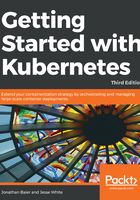
上QQ阅读APP看书,第一时间看更新
Other modes
There are various other modes to take into consideration, including the following:
- Build a terraform model: --target=terraform. The terraform model will be built in out/terraform.
- Build a cloudformation model: --target=cloudformation. The Cloudformation JSON file will be built in out/cloudformation.
- Specify the K8s build to run: --kubernetes-version=1.2.2.
- Run nodes in multiple zones: --zones=us-east-1b,us-east-1c,us-east-1d.
- Run with a HA master: --master-zones=us-east-1b,us-east-1c,us-east-1d.
- Specify the number of nodes: --node-count=4.
- Specify the node size: --node-size=m4.large.
- Specify the master size: --master-size=m4.large.
- Override the default DNS zone: --dns-zone=<my.hosted.zone>.
The full list of CLI documentation can be found here: https://github.com/kubernetes/kops/tree/master/docs/cli.
Another tool for diagnosing the cluster status is the componentstatuses command, which will inform you of state of the major Kubernetes moving pieces:
$ kubectl get componentstatuses
NAME STATUS MESSAGE ERROR
scheduler Healthy ok
controller-manager Healthy ok
etcd-0 Healthy {"health": "true"}